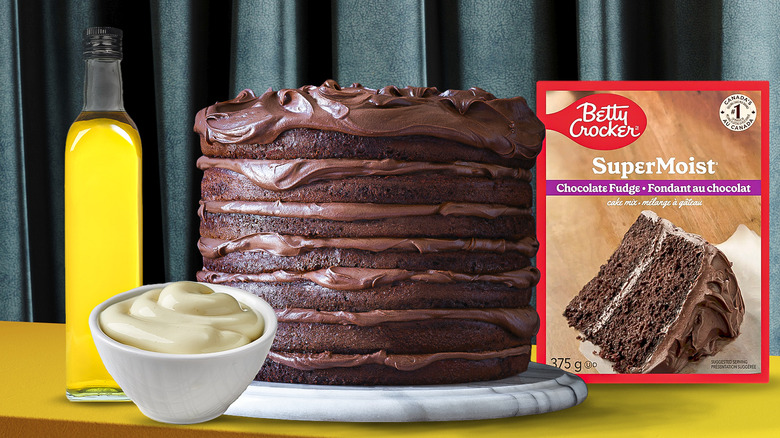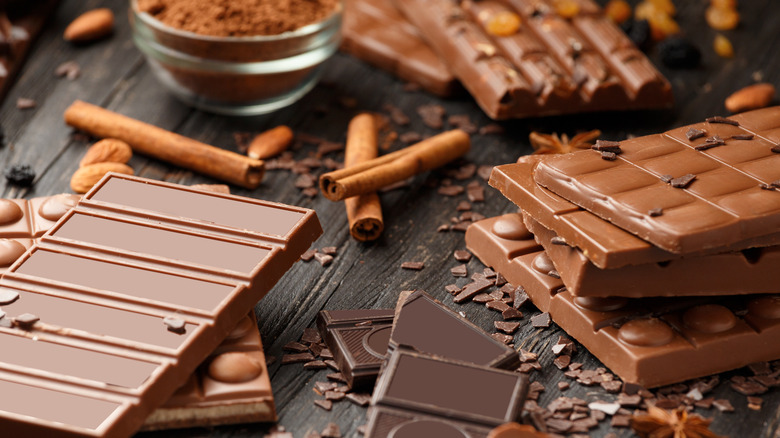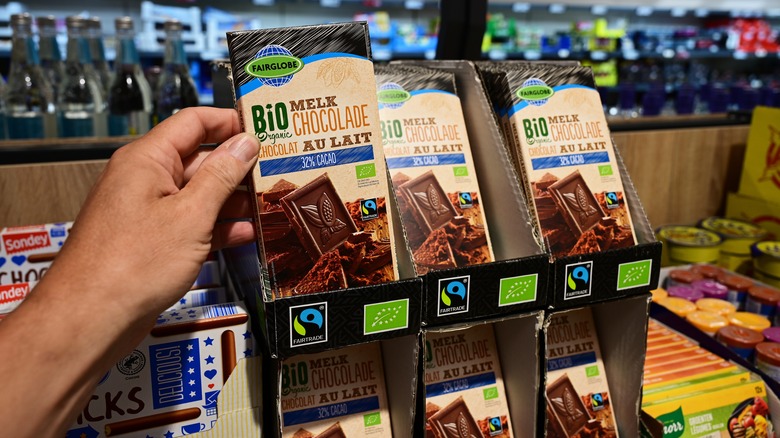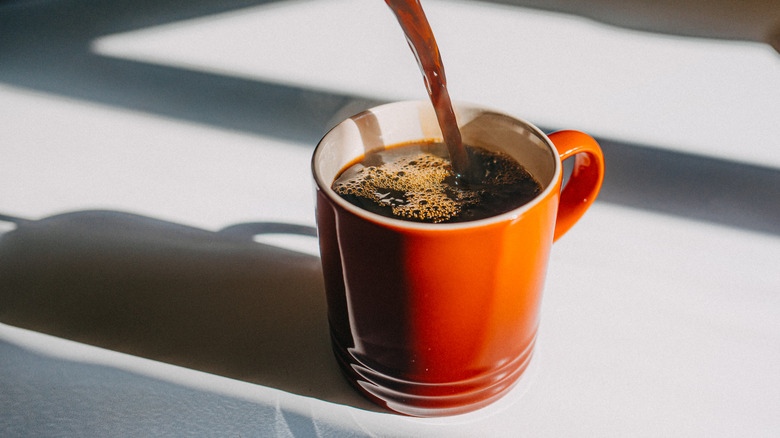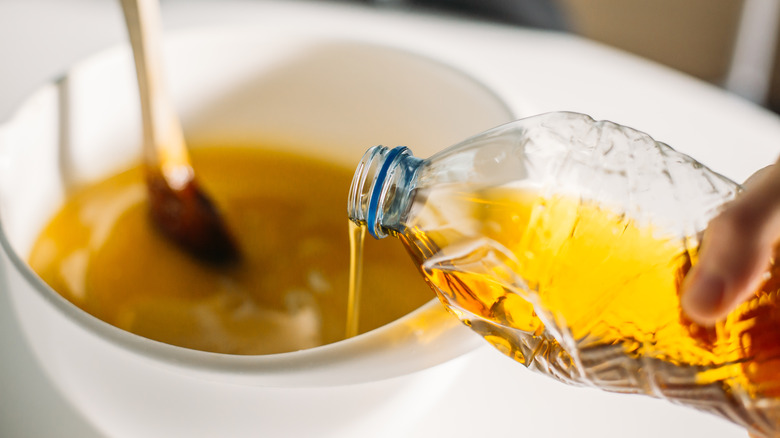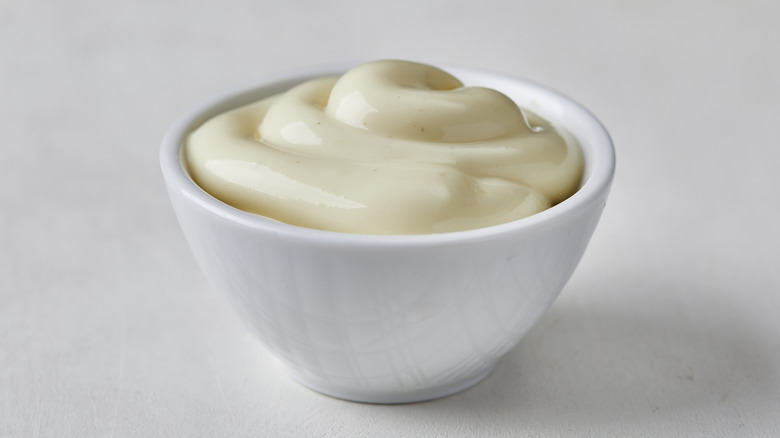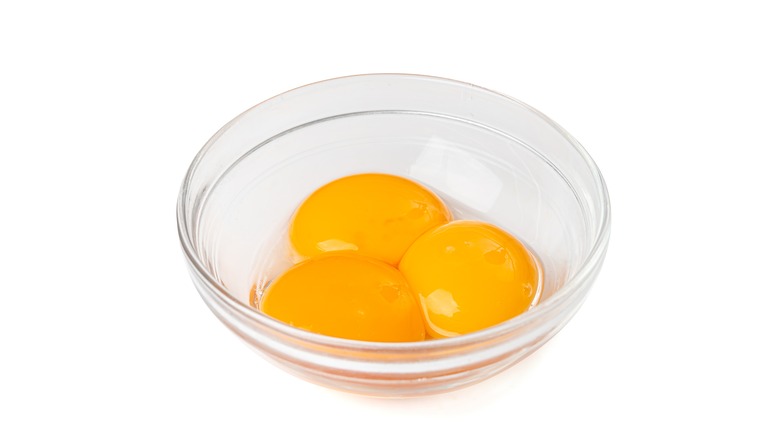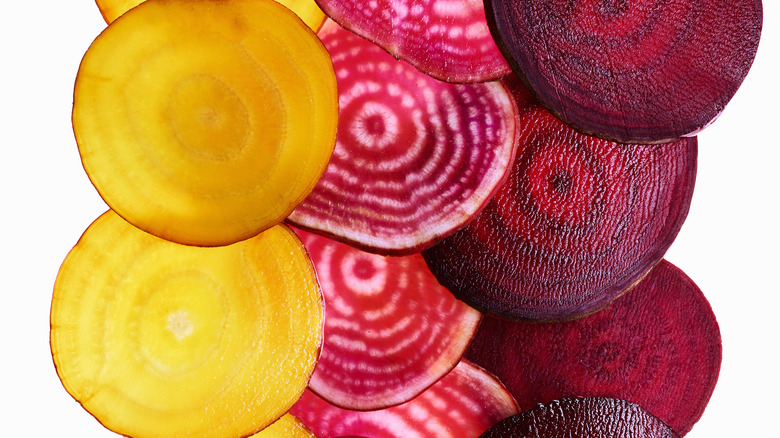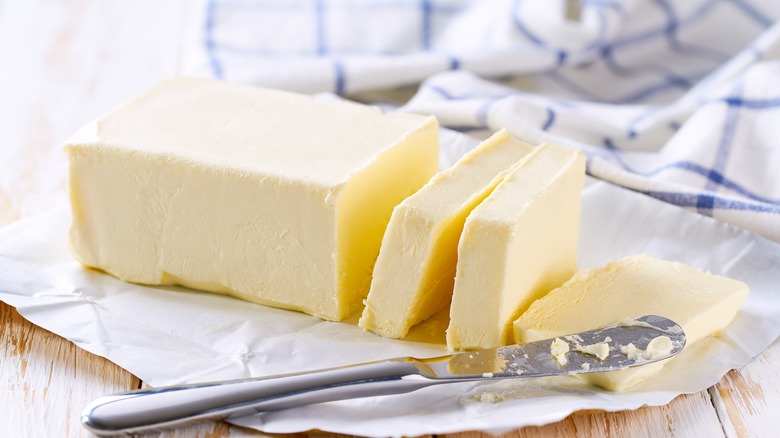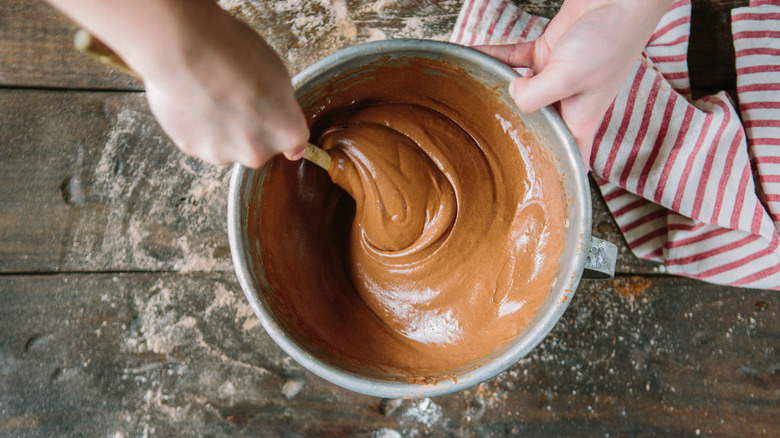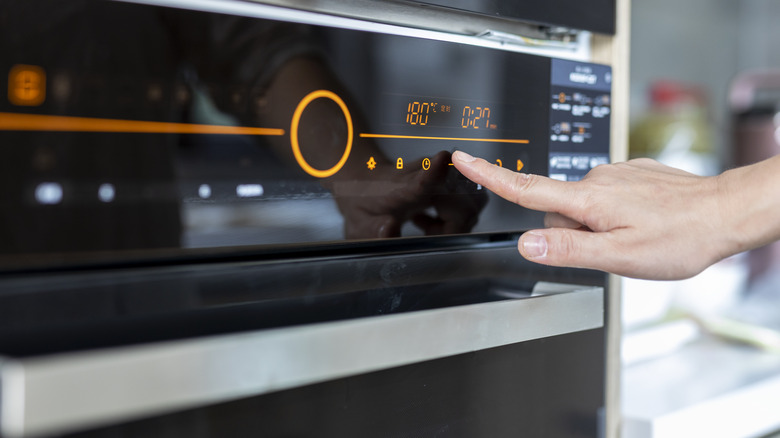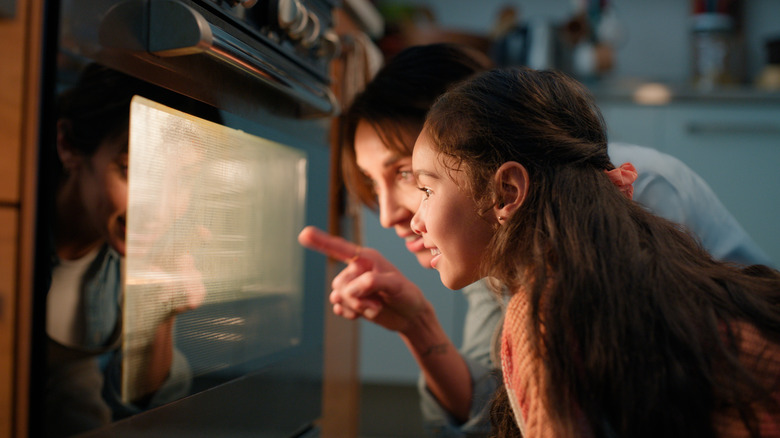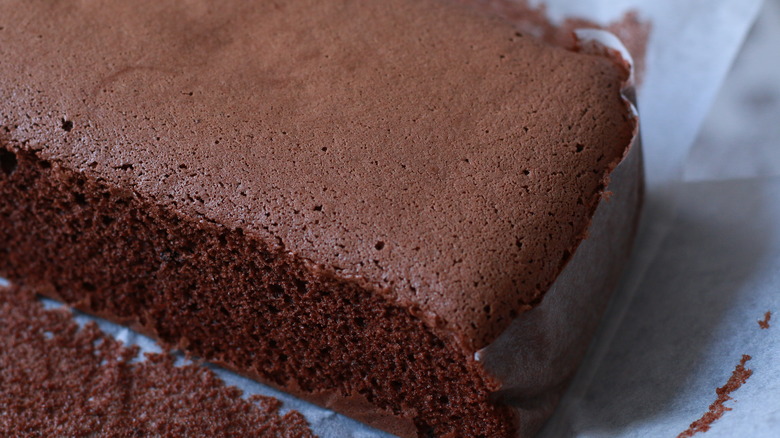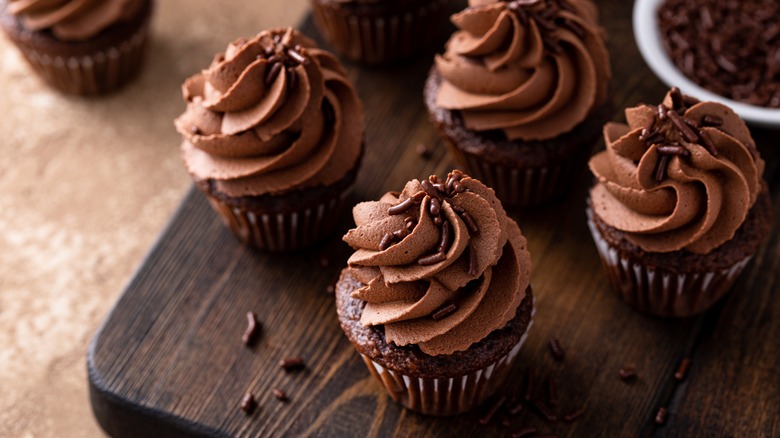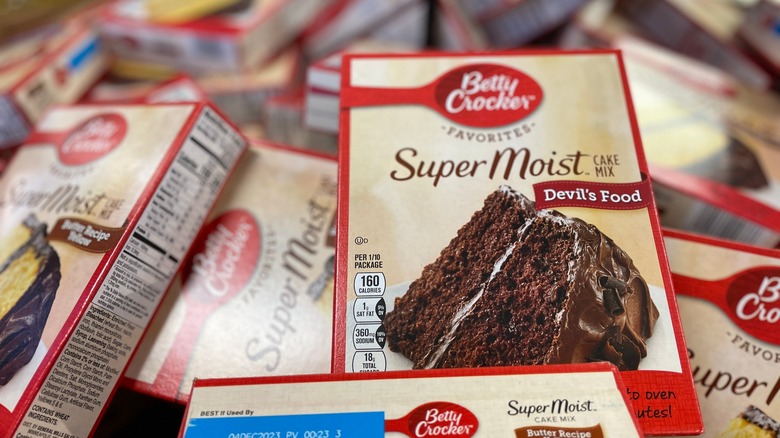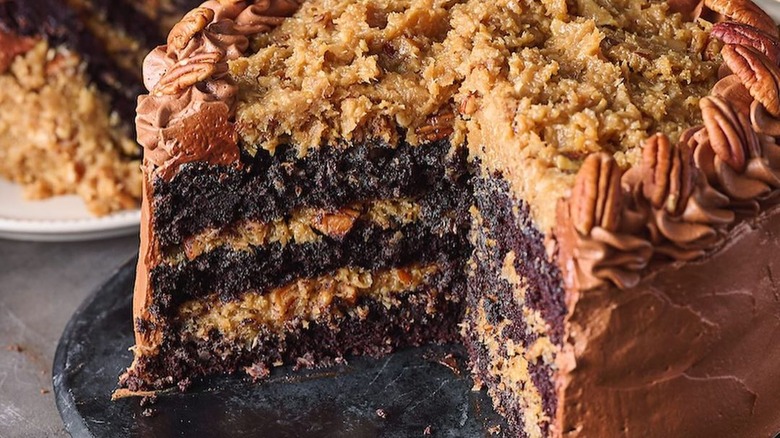Expert Tips For Bakery-Worthy Chocolate Cake
Chocolate cake is a tried-and-true dessert enjoyed by everyone from babies to great-great-grandparents, but many of them turn out dry, crumbly, soggy, or just plain underwhelming when you bake them at home. When it comes to a dessert so universally beloved, that's just plain unacceptable. The simplest things are the most impressive in the culinary arts, so it's worth learning to make chocolate cake well. Once you get a recipe that works, you'll be the envy of every baker in the neighborhood.
The good news is, much like baking with chocolate in general, making a great cake is easier than you think. From using the right ingredients to making a few special additions to taking the right approach to time in the oven, you can easily upgrade your approach. And since chocolate cake stores so well, you needn't worry about making too much of it. (Although was that even a concern, really?) Before you can worry about anything, though, it's time to perfect your technique.
Use the right type of chocolate
The right type of chocolate matters. If the recipe calls for a certain type of cocoa powder or baker's chocolate, use it. The $4.99 tubs from Hershey's simply won't give you the right effect if the recipe asks for something else, so always pay attention to the recipe. That doesn't mean, of course, that you can't make a few updates of your own in the classier direction.
"I use Dutch-process cocoa powder for a richer, more intense chocolate flavor," Marissa Stevens of the cooking blog Pinch and Swirl said. But, she added, there's a caveat. "This type of cocoa is less acidic, so you might need to adjust [leavening agents] if your recipe uses baking soda." That's because Dutched cocoa is made through a process that neutralizes chocolate's natural acidity, so it doesn't react with baking soda. Therefore, you might need to substitute baking powder instead to get the rise you're looking for in a cake.
Professional baker Ali Gogarty, also known as Morristown Cake Lady, agrees, pointing out that homemade chocolate cakes often lack that deep brown, almost black, quality. "When I picture a bakery chocolate cake, it looks more like a devil's food: dark color and rich chocolate flavor," she said. "Using a high-quality, dark chocolate cocoa powder will contribute significantly to that difference."
Select high-quality chocolate brands
As for brands of chocolate, that's really up to you. Sometimes the recipe will specify a certain chocolate percentage, in which case you can simply follow its instructions. Make sure you know the difference between all the types of chocolate, though. Baker's chocolate and chocolate chips, for instance, may or may not be interchangeable. Note that the types you bake with are different from the products you eat, such as bars or chocolate fudge. You may also look for characteristics such as low lead and cadmium levels, but that is up to personal preference.
It's a good idea to find brands you love for both baker's chocolate (the kind that comes in a solid bar) and cocoa powder, as many professional chefs recommend pairing both in a chocolate cake. Food Network's "Chopped" Champion and private chef Julia Chebotar of Health Chef Julia is an advocate for this approach. "Cocoa powder provides a strong chocolate flavor, while baker's chocolate adds richness and helps with the cake's texture," she said. "Together, they make a beautifully balanced and intensely chocolatey cake." Ali Gogarty agrees, saying, "I use dark cocoa powder in the cake, but I use melted baker's chocolate in my chocolate buttercream to give it a rich chocolate flavor and firmer consistency."
Make the flavor more intense
Bakery chocolate cakes usually have a deep, rich, moist flavor that home cakes often don't replicate unless you use the box mix (at which point they take on that fakey Costco vibe that, while delicious in its own way, doesn't taste at all like a nice bakery cake). There are ways to make the flavor more intense, though, beyond choosing the right cocoa powder and baker's chocolate.
Coffee is a go-to for Marissa Stevens. "Add 1 cup of hot, strong coffee to the batter," she said. "It deepens the chocolate flavor without making the cake taste like coffee." But, she said, it's important to remember that "this replaces 1 cup of liquid in your recipe, so adjust other wet ingredients accordingly." And that's not all. "Include 1 teaspoon of espresso powder in the dry ingredients. This amplifies the chocolate notes without adding coffee flavor." Even better news? You can use coffee in both the batter and the frosting, as Ina Garten does.
Beyond the cup of joe, the best way to improve a cake's flavor is salt. "Don't skimp!" Julia Chebotar said. "Just a pinch can really bring out the chocolate's complexity. Especially flakey sea salt!" Also, if you want to go the whole nine yards and really mirror a professional cake, consider using cake flour, Ali Gogarty said. The grain is ground extra finely, making for a lighter and fluffier crumb. It's a small and inexpensive swap for a big difference.
Swap butter for oil
Because cocoa powder is so dry, and because it is an element in almost every chocolate cake recipe, you're going to need a technique for absorbing moisture into that dryness. The secret? Swapping out butter for oil. "The science behind this is that oil is 100% fat, while most butter is only about 80% fat and 20% water," Marissa Stevens explained. "More fat equals more moisture!" She often uses ½ cup of avocado oil instead of the same amount of butter, so adjust accordingly.
It's true that oil lacks the same flavor, but that buttery taste will mostly get overwhelmed by all the chocolate and coffee anyway, and oil does a much better job dissolving dry ingredients. If you don't feel like replacing all of the butter because you really like its flavor, that's fine. Just add in a little extra oil along with the butter, said Julia Chebotar.
Try the mayo trick
Mayonnaise is magical, there's no denying it. It can turn dry chicken into a beautiful salad, a dull sandwich into fatty heaven, and (as it turns out) cake into a rich, chocolatey paradise. "If I'm being honest," Marissa Stevens said, "it's my top tip, one that I learned from my grandmother, Anna Belle." Simply throw ½ cup of mayo into the cake batter; no need to adjust anything else. "It sounds odd, but it makes the cake incredibly tender," Stevens said. "Why? Mayo is mostly oil and eggs, both of which contribute to a moist, tender crumb."
Plus, mayo often contains an emulsifier called lecithin. This helps the oils in the recipe stick to the protein in flour, which makes the final product moister. A little bit of extra acid in the form of vinegar or lemon juice, which most commercial mayonnaises also include, can also go a long way. Acids help to break down and tenderize proteins in flour, as well as cause cakes to set more quickly with less rigid structures, which makes for a more delicate result overall.
If you're avoiding eggs, that's okay. Julia Chebotar recommends Greek yogurt, buttermilk, or sour cream. "They add moisture and a slight tang that balances the sweetness, making the chocolate flavor shine even more," she said. "They also give the cake a soft, tender crumb that's really satisfying."
Add some extra egg yolks
If you want your cake to taste extra rich, try adding an extra egg yolk or two. Like the mayonnaise, you don't need to adjust your recipe in any other way; just throw in the yolks along with whatever other wet ingredients are called for. "The added fat creates an even more velvety texture without needing to adjust other ingredients," Marissa Stevens said.
This works because, like mayo, egg yolks act as emulsifiers, essentially making wet and dry ingredients stick to each other well. This ensures that your batter is moist and evenly mixed and will stay that way during the baking process. Do some experimenting with both egg yolks and mayo before adding them both at once, though, as that's a bold move. You may find that adding both leads to a nice result, but depending on the recipe, one may be enough. (Mayo is made of eggs, after all.)
Experiment with beet puree (and other healthy ingredients)
Although it sounds like just about the most disagreeable ingredient you could imagine, beet puree can work magic in a cake. No, you won't taste it. Yes, you'll be glad it's there. Marissa Stevens swears by this trick. "I know it sounds odd, but you don't taste the beets, and it adds this luxurious texture to chocolate baked goods." You can also use it in brownies, she said. "To make the puree, I typically roast the beets for flavor depth, but you could boil or steam them too."
If you're looking for other healthy upgrades, Julia Chebotar recommends subbing in some almond or oat flour for extra nutrients. You can also use natural sweeteners such as coconut sugar or maple syrup. Ali Gogarty said it's pretty easy to make your cake vegan, too. "Substitute aquafaba for eggs and almond or coconut milk (mixed with 1 tablespoon of apple cider vinegar) for milk," she said.
Understand that room temperature ingredients matter
Most recipes tell you to let your eggs, butter, etc. come to room temperature. Most of us ignore this advice. Indeed, this writer routinely did so her entire life, until one day asking her sister-in-law how the cookies she made tasted like they came from the bakery. The answer? Sis let her ingredients warm up all the way. It matters, and there's a scientific reason for this.
Room-temperature ingredients are capable of trapping air in a way that cold ingredients simply are not. That air gets trapped during mixing and then expands in the heat of the oven. This leads to a lighter and fluffier result that you will not see if you skip the step and use cold eggs, milk, and so on. There's another reason to do it as well, according to Marissa Stevens. "Cold ingredients can lead to a lumpy batter and uneven baking," she said. "Be sure all ingredients are at room temperature for better incorporation."
Don't overmix
We all want even cake batter. Yet vigorous mixing to ensure total incorporation develops the gluten in the flour, so it can lead to a dense and unpleasant cake. Improper mixing is one of the reasons that you'll get a better cake at the store or a bakery, according to Julia Chebotar, because commercial-grade equipment just does a better job. If you find that you're not able to mix your ingredients quickly and well, you might want to try a stand mixer.
However, it's important to remember that a cake does need to be properly mixed. Some folks are so afraid of overmixing that they accidentally swing in the other direction, leading to a cake whose ingredients aren't thoroughly blended. Worse, this fails to develop the gluten enough, and thus the cake cannot hold itself together, which can lead to fudgy and undercooked batter on the bottom.
On a final note, it's important to adjust your approach if you're not using standard flour. The packaging on gluten-free blends might say 1:1, but you can't treat it the same. "You have to mix the batter for five to seven minutes rather than the two to three you normally would and let the batter sit for about 20 minutes before baking," Ali Gogarty said. That way, the flour can absorb the liquid.
Avoid overbaking
Overbaking is another serious issue. Exposure to dry heat in the oven is necessary to transform your cake from batter to crumb, but too much of it can remove the moisture entirely and leave you with a disappointing final result. "The cake continues to bake a bit as it cools," Marissa Stevens explained. Thus, "a cake tester or toothpick inserted into the center should come out with a few moist crumbs, not completely clean." If you see no crumbs, you've gone too far.
Then there's the fact that your oven may cook hotter than the one used in the recipe, so you should always err on the side of caution. Set your timer for a few minutes less than the recipe calls for and test. You can always cook it longer, but never shorter.
Resist the urge open the oven door
Like a frantic "Great British Bake Off" contestant, you worry about your cake while it's in the oven. Although it's tempting to open the door and check on it, resist the urge. The cold air you let in can do serious damage to your poor cake, causing it to stop rising. This in turn makes it collapse and lose its definition and fluffy crumb. Instead, if you insist on watching your cake, do so by turning on the oven light. Better yet, go listen to a podcast and get some steps in.
Ideally, you should wait until the cake is at least three-quarters of the way cooked before you open the door to check on it. This should give it enough time to develop its structure. Once you're done checking, try to wait at least five more minutes before opening the oven door again. If your cake is getting too brown on top but still isn't done, throw some foil over it to protect the top.
Turn your cake
Have you ever found that your cakes rise weirdly or aren't completely cooked in some places, while being overcooked in others? You're not alone. This is another of the pitfalls between commercially baked and homemade cakes. "Most home ovens don't heat completely evenly, while bakery ovens are going to be better regulated for a more even bake," Ali Gogarty said.
Don't worry, there's a fix: "I rotate my cake pans halfway through baking so they cook evenly," Gogarty said. While this might not exactly lead to commercial-grade results, you'll at least avoid the bizarre effect of a mountain on one side and a valley on the other. This will also avoid drying and scorching your cake in some areas since most ovens have hotspots. Once you minimize the problem, you can address any leftover imperfections with frosting.
Make rich, chocolatey frosting
A good frosting is, no doubt, one of the most important aspects of chocolate cake. "A classic chocolate ganache is my go-to for chocolate cake," Julia Chebotar said. "It's rich, glossy, and only requires two ingredients: chocolate and heavy cream. You can pour it over the cake while it's warm for a smooth, shiny finish or let it cool a bit for a thicker, spreadable texture." However, she adds, a whipped chocolate buttercream made with a touch of sea salt is a great substitute if you want something a little lighter.
For her frosting, Marissa Stevens likes to use a combination of semi-sweet and dark chocolate for a more complex flavor. A 50/50 split does the trick nicely, she said. Keep in mind, though, that chocolate frosting isn't a must. "One of the favorites in my business and family is vanilla buttercream and raspberry jam filling, covered in vanilla buttercream and coconut flakes," Ali Gogarty said.
If you find your chocolate turns grainy while making frosting, that's usually because you did something wrong, but fixable. Usually, it's a heating issue. If you get chocolate too hot, it will go grainy, and the fat will separate out. Try keeping the heat more moderate next time, and don't add chocolate to other ingredients until it has cooled.
Upgrade your boxed chocolate cake
If you don't have the time or will to make yourself a cake from scratch, that's okay. You can upgrade boxed cake to make it taste like it came from a bakery ... with the bonus of still being able to tell people that you "made it yourself." There are several ways to do this.
First, mixing hot water into your boxed cake mix instead of cold goes a long way toward making your cake lighter and fluffier. You can also add zucchini to a boxed mix for extra moisture (and to hide some veggies from the kids (or husband)).
If that's not enough, you can add all sorts of other ingredients to elevate chocolate cake. These include, but certainly aren't limited to, tea biscuits, hot chocolate, bananas, sour cream, and sauerkraut. If the last one has you majorly raising your eyebrow, well, yeah ... same here. But don't knock it 'til you try it, right?
Store your cake correctly
Ever been impressed that bakery cake is just as good a day or two (or four) later, while yours tends to dry out pretty quickly? There's a reason for this, mostly coming down to the moisture content of the ingredients, which as discussed, you can improve in multiple ways. No matter how you make your cake, though, there are strategies for extending its shelf life.
First, never store an unfrosted cake without wrapping it. Instead, wrap it in plastic and then cover it with a layer of foil or put it in an airtight container. The same goes for a frosted cake, according to Ali Gogarty. For that, you should "double wrap [it] in plastic, making sure the plastic wrap is touching every surface of the cake, and then store it in a Ziplock bag or sealed Tupperware container."
Julia Chebotar said that chocolate cake can be stored at room temperature for up to two days wrapped only in plastic, after which you should put it in an airtight container and put it in the fridge. Want to freeze it? "Wrap each slice individually and store it in a freezer-safe bag," she said. "It'll stay good for up to three months!"
